Top: Larcomar Mall in Miraflores, Municipal Palace of Peru
Bottom: Park of the Reserve, Pisco Sour at the Grand Bolivar Hotel
Top: Larcomar Mall in Miraflores, Municipal Palace of Peru
Bottom: Park of the Reserve, Pisco Sour at the Grand Bolivar Hotel
Kate and I decided to take a bus to Lima, Peru on Tuesday night.
From Cuenca, Ecuador to Lima, Peru it should take around 22 hours, driving straight through. Unfortunately, no bus companies have a direct bus connecting these two cities.
First, we decided take the bus from Cuenca, Ecuador to Huaquillas, Ecuador. In Huaquillas, we would cross the border, get our passports stamped, and continue on our course by bus to Piura, Peru, which is about four hours south of the border. We bought bus tickets online to take us the rest of the way to Lima. If all went well, the travel time should have been 25-30 hours.
We had a few different reasons. The first was I wanted to write an in-depth article about the experience of crossing the border in Ecuador when traveling to Lima. I think many travelers take this route and the opportunity to help people by offering a strong guide would be beneficial to those people and to our site. Another reason we chose to take the bus was the opportunity to save about $120, which can now be allocated to another part of our trip. Traveling by bus gave us the opportunity to see the desert of Northern Peru — Rolling sand dunes are not something I get to see everyday. Lastly, after traveling in China, I found that long bus rides help me learn about and practice patience.
I recently read Siddhartha by Herman Hesse. At one point in the poem, Siddhartha was having a conversation with a merchant. He had recently given up all of his worldly possessions and the merchant asks what Siddhartha can give to him. His response, “I can think, I can wait, I can fast. That is all.”
So while we were riding on three different buses on a trip that lasted just over 37 hours, I was thinking about the practice of patience and waiting. I have wanted to see Machu Picchu for years, but have known it would take a bit of patience to get there. I am learning that if I can develop this strong practice of patience, everything I need or want will eventually come. The bus ride proved to be no different. It seemed difficult and long at first, but after a while we were in a groove and it really was just another day.
“Practice and all is coming.”
If you are present in this moment, you are successful…right now, this moment….this is where we are meant to be.
AsapSCIENCE provides a helpful overview on the research into lucid dreaming.
We had heard great things about the small west coast Thai beach called Railay Beach. Our friend Jason whom we respect in many aspects of life — especially Thai travel — recommended insisted that we check out Railay Beach.
We decided to move north from Langkawi, Malaysia and our first stop was Railay Beach in Krabi.
Railay Beach is a hidden gem. The type of spot veteran backpackers try to keep a secret. This tiny paradise island peninsula is hidden on the West Coast of Thailand and is only accessible by boat because of the monstrous limestone cliffs that barricade it.
Railay Beach features beautiful white sand beaches and the gorgeous, crystal clear waters Andaman Sea. Railay Beach is located between the city of Krabi and Ao Nang in Thailand. The limestone cliffs of Railay Beach make for some of the best climbing in the world.
Railay Beach is also popular due to its quiet relaxing atmosphere. Accommodation ranges from bungalows and medium-priced resorts in East Railay to a collection of five-star resorts focused on West Railay. The four main areas of Railay consist of Tonsaid, East Railay, West Railay and Pranang. Backpackers tend to congregate and lodge in the Tonsai portion of the beautiful, remote peninsula.
Railay Beach is in the Southwestern part of Thailand, 120 miles north of the Malaysian border and 100 miles south or the Burmese (Mynamar) border. Railay Beach is 25 miles east of Phuket.
If you want to bus from central Malaysia, take a bus to Hat Yai, Thailand. In Hat Yai you will probably be dropped at a tourist transport office – they will always be looking to help you there. From there jump on a bus to Krabi.
How we did it: We caught a ferry from Langkawi to Satun, Thailand. There we bought minivan tickets to van us to Krabi (5 hrs, 230 Baht, $7.5 USD). This was very simple as opposed to the first option.
Beware that there will be several “pointless stops” along the way. If you’ve ever traveled in Thailand, you know that the buses stop every 30 miles or so for no reason at all. The driver lets everyone out in the hopes that you’ll buy something from the store. The drivers no doubt receive kickbacks from the store for these “pointless stops.” It got to the point where I would say to Brian, “Another pointless stop?” and Brian would laugh and reply, “Yeppp.”
From Krabi you get to take a small fishtail boat (with a lawnmower engine) over to Railay Peninsula (100 Baht, $3 USD). This was quite an experience for us because a thunderstorm erupted on our way over. For a few seconds, we thought about ditching our backpacks and jumping overboard!
There a few ways to get to Krabi from Bangkok.
First option: Sleeper bus. While it takes 12 hours to get there, a price point around 500 Baht ($17 USD) is not a bad option.
Second option: Train. Krabi does not have a railway station, but it’s easy to get there using a comfortable train to Surat Thani and then an air-conditioned bus. Using the overnight sleeper train from Bangkok (8.5 hrs), the train & bus to Krabi takes the same amount of time — it’s just much more interesting and inexpensive. (800 baht/$27 USD)
You will find buses to Krabi waiting at Surat Thani station once your train arrives. The bus fare is about 200 baht ($6.5 USD), the journey time from Surat Thani to Krabi takes 3 hours. You can purchase a train+bus combo ticket from Bangkok to Krabi.
From Krabi you get to take a small fishtail boat over to Railay Peninsula (100 Baht, 3 USD). You will arrive at East Railay Beach.
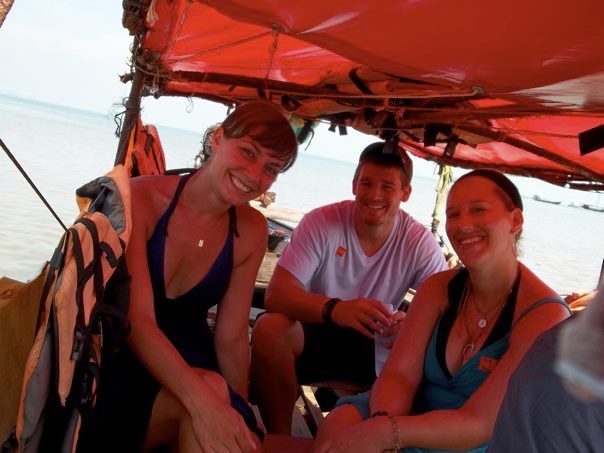
Brian w/ our Backpacker Friends on Way Back from Railay Beach to Krabi (tarp over our heads this time) 😉
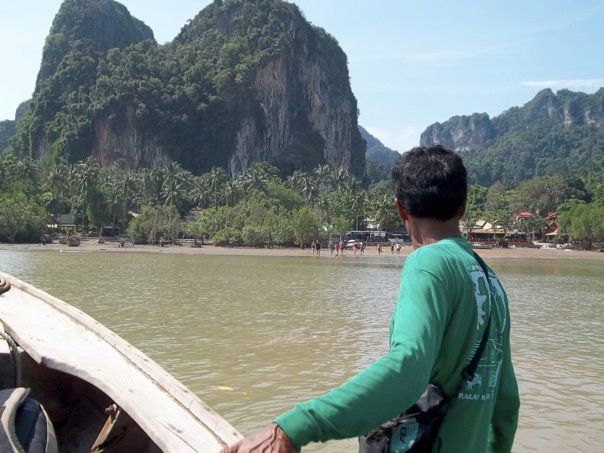
Your boat might stop here if it’s low tide and the water is too low. You walk the rest of way to East Railay Beach!
This is where your driver might stop the boat. The water gets very shallow (about .5 meters or 1.5 feet) — the engine would get ruined if he drove it up to shore. Be sure to have sandals (and good balance) for this walk!
You can explore the whole island in 4-5 days so it depends on what type of experience you’re looking for. We’re always in favor of traveling slow. We were content with reading books on the beach and casually exploring every little nook and cranny the island had to offer. You could easily stay here for a month if you’re a traveler that likes to take things slowly but we found that one week was a nice stay.
Railay has not been a major backpacking destination for a long time (this place was the undiscovered and a backpacking mecca in the 70’s and 80’s), so there are not many formal hostels. We were able to find cheap accomodation ($10 USD per night) but opted to stay in a slightly nicer place for $15 USD per night.
Be aware that the 1st of November prices at Railay are still at low season rates so it might be worth shopping around once you arrive. Have a walk around to see what you can get deal wise. It is a very small place so it won’t take long.
You’ll arrive via fishtail boat at East Railay Beach. You cannot swim or climb here but you’ll likely spend the bulk of your time here (lodging, eating, shopping, bars, etc.). For climbing and beach lounging, you’ll be on West Railay Beach. Not to worry, the entire peninsula is 2 square miles or 3.5 square kilometers.
1. Railay Beach Rock Climbing. Enough said. Scale the cliff or watch some of the world’s greatest climbers scale the challenging cliffs of Railay.
2. Chill out on the Phra Nang portion of Railay West Beach (a short walk from Tonsai where you’ll probably stay if you’re a backpacker)
3. Walk through Phra Nang Cave (this is how you get from East Railay to West Railay Beach)
4. Shop for unique, inexpensive local handicrafts and clothing on East Railay Beach
5. Go to the Rasta bar called “The Last Bar” for a Rasta music, a drink, and to see the Rasta Man and his pet otter
Fresh seafood from the fisherman and local fruit. Also, don’t miss the indian rotis! Sit right on the water on East Railay as you enjoy tea, indian roti with banana and peanut butter along with the perfect sea breeze of the Andaman Sea.
Hostel: $15 USD
Food: $14 USD
Transportation: $0 USD (no roads or vehicles on the entire peninsula)
Railay is a bit more expensive than comprable areas probably because the difficulties in transporting food to the peninsula. Think about it — every item of food that does not grow on the island peninsula, has to be transported on a small fishtail boat with a lawnmower engine. It’s really quite a unique process!
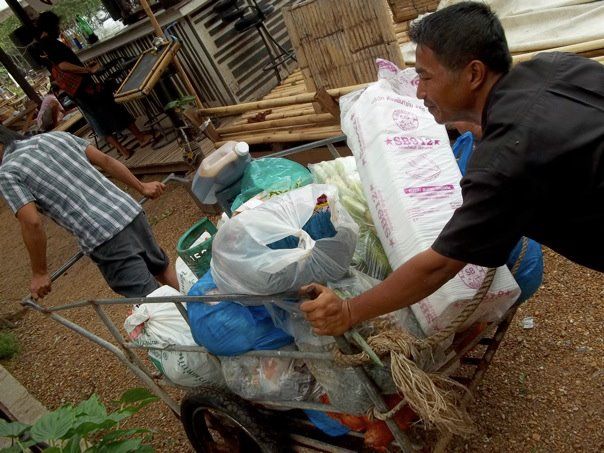
Locals transporting garbage from the island to a fishtail boat to dispose of it on the mainland of Krabi
Overall, Railay is a very laid back (no roads!), beautiful, interesting place with great food and friendly people.
Check out our other travel posts:
Traveling to Thailand for the first time? Post a question in the comments section below, we’ll respond with advice!
If you liked this post, please share it with friends and leave a comment!
~ Malala Yousafzai
Overcoming Asana has a very detailed piece on jumping back in Ashtanga Yoga. I encourage all yoga practioners to read it when they have the opportunity.
“Iyengar talking about his guru Krishnamacharya in an interview from the movie Enlighten up.
Iyengar is focusing on the ‘jumping’ aspect of Krishnamacharya’s teaching and explaining it as a result of Krishnamacharya teaching the warrior class boys of the Mysore palace. Practice as exercise, as fitness, somewhat akin to a ‘martial art’.

Cartagena is a beautiful and historical city on the Caribbean coast of Colombia. It is ranked as Colombia’s top area for tourism and boasts many museums and ornate churches as well as beach views and a warm tropical climate. Whether your ideal destination is one with old city charm, exciting nightlife, or somewhere to work on your tan, Cartagena is sure to please.

Colombia exclusively uses the Colombian Peso as their form of currency. Roughly speaking, $1 USD = $2,000 COP. We recommend you exchange as little currency as possible. Instead, withdraw pesos from ATMs (“cajeros” in Spanish) which are available in the airport, bus station, and all over the city offering the best exchange rate.
How to get to Cartagena, Colombia from Panama City, Panama: Sail. Crossing from North America to South America by land is not possible at this time because of the roadless area separating the two called the Darien Gap. The best solution to crossing the border to the Caribbean coast of Colombia is to book a ride on a sailboat. These boat trips usually cost $450-550 USD per person. While this sounds very, very expensive, these trips include all of your food and housing for five days and take you on a once-in-a-lifetime trip to Panama’s San Blas Islands.
Stephanie at itravelbyboat.com is a great person to get in contact with to schedule your trip. She always keeps an up-to-date schedule of all the captains in the area and will help you arrange transportation to the port. I have heard incredible things about the Independence, a 26 passenger sailboat. The bigger the boat, the more comfortable ride you’ll have and, of course, the more new friends you’ll meet!
Note: The first three days are spent enjoying the San Blas Islands, however, the last two full days are spent crossing the open sea. Be sure to bring seasickness medication!
The other option is flying. Flights from Panama City, Panama to Cartagena, Colombia cost $300-450 USD and usually have a connection in Bogota. I strongly suggest spending the extra $100-150 USD to sail and get an extra four days of incredible experiences out of this trip!
How to get to Cartagena, Colombia from Bogota: Fly. If you are able to book at least a week in advance, you can purchase this quick flight for $45-70. This sure beats the 20 hour bus that costs the same amount.
How to get to Cartagena, Colombia from Medellin: Bus. This bus takes 13-14 hours and costs $104,000 COP per person before negotiation. Colombian bus prices are negotiable! Work your magic. I took a night bus and suggest this option. The route is safe and the bus is comfortable with reclining seats and a bathroom on board. Bring a blanket and dress warm — the air conditioning is on max all night long. Earplugs are also necessary for this trip, as the music is still blaring past 3:00 AM.
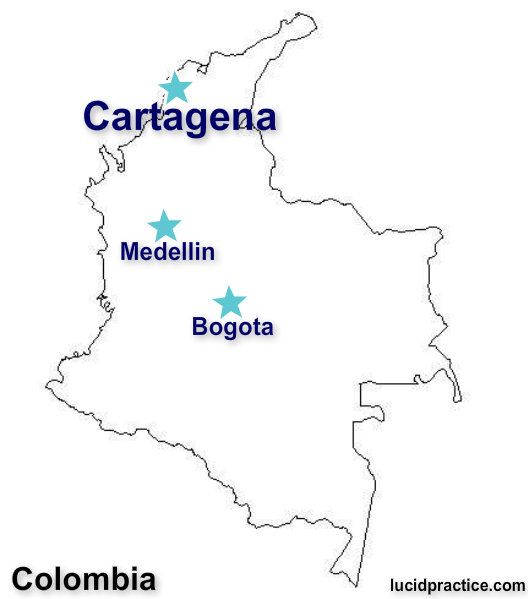
1. Walk the Wall. The historical area of Cartagena is known as The Walled City. As you may have guessed, this area is surrounded by a massive stone wall that dates back hundreds of years to the Spanish Colonial era. The wall is still intact and is a popular and free tourist attraction for all who visit the city. Wait for the heat to break when the sun starts to set and take a walk on the wall around the city. The best time to do this is before 10:00 AM or after 5:00 PM, as the walk is just too hot otherwise. Why not grab a $1,500 COP ($.75 USD) can of Aguila Cerveza or $1,000 COP ($.50 USD) lemonade and watch the sunset over the water?
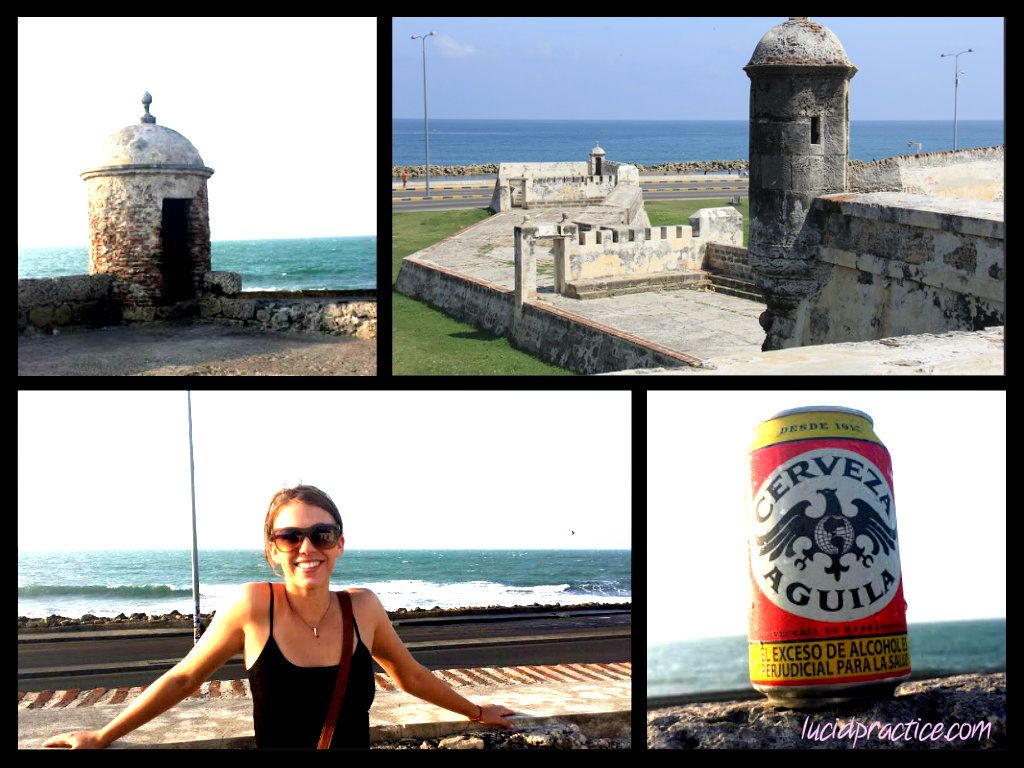
Walk along the Wall in Cartagena
2. Sight-see in the Walled City. Grab your sunscreen, hat, and sunglasses and get exploring. Everything in the Walled City is in walking distance, so check out some of Cartagena’s many churches, including Iglesia de San Pedro Claver, which was named in honor of its priest after his role in helping African freed slaves. There are numerous museums to stop in as well, most ranging from $7,000-$15,000 COP ($3.50-$7.50). The Museo de Oro (Gold Museum) has no admission fee, is air conditioned, and is open Tuesday-Friday.
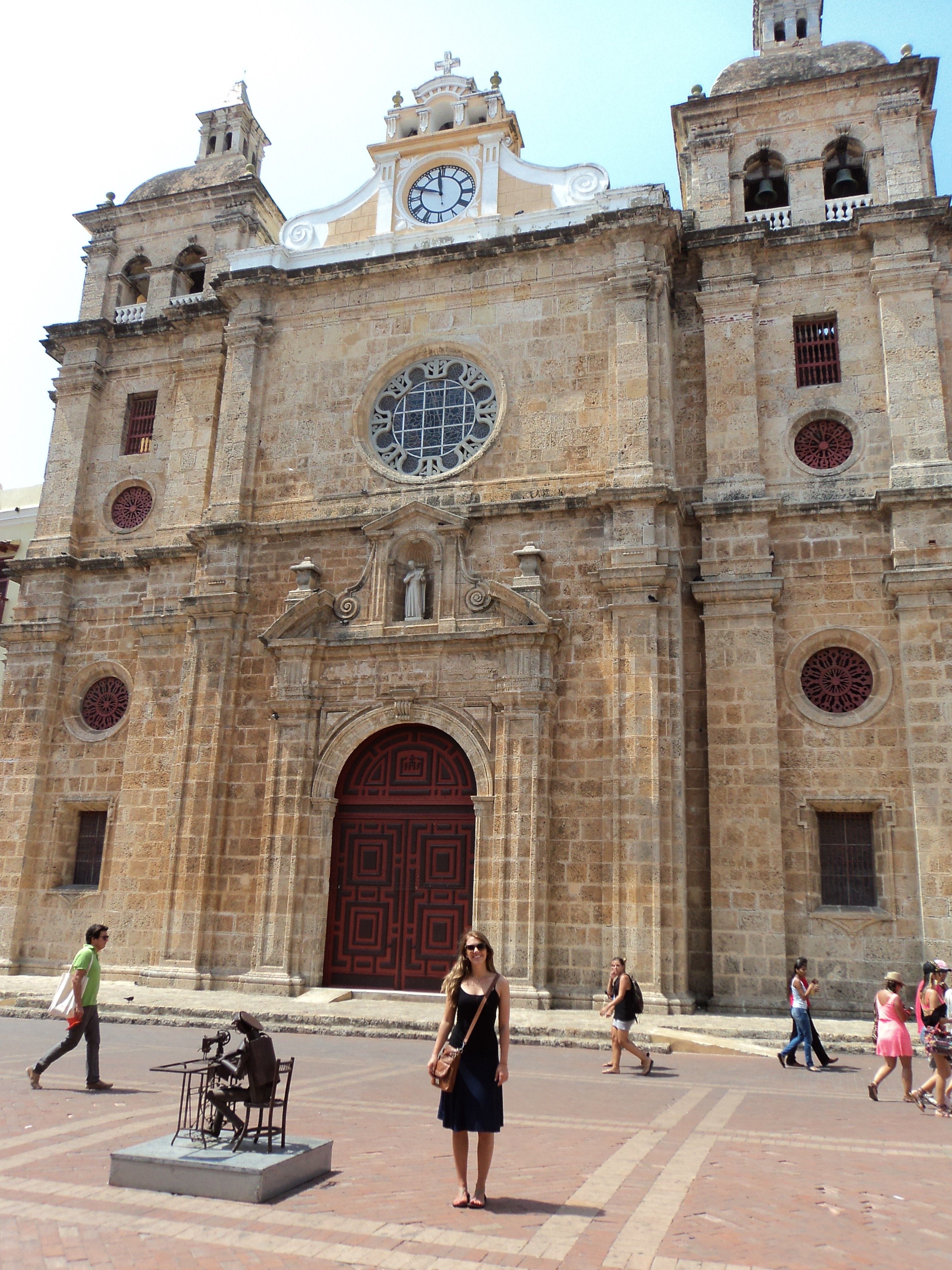
One of many ornate churches in Cartagena, Colombia
3. Hop on a Party Bus. Open air “Chiva” buses constantly tour Cartagena just outside of the Walled City. You can spot them by their bright colors and bumping music. Colombian and foreign tourists bring their own drinks and enjoy this ride around the city. Prices can vary so have your Colombian negotiation skills ready!
4. Visit Castillo San Felipe de Barajas (the San Felipe Castle). Its called a castle, but its more of a fortress. This 350 year old castle was built, along with the wall, to protect Cartagena from pirates. It takes around 20-25 minutes to get here on foot from the Walled City. You won’t be able to miss this mammoth structure in the midst of an otherwise normal part of town. The real attraction of the castle is its role in the history of Cartagena and the sheer size of it. Skip the $20,000 ($10 USD) COP admission fee and appreciate it from outside. Inside the castle grounds, there are no guides, no information offered, and no museum.
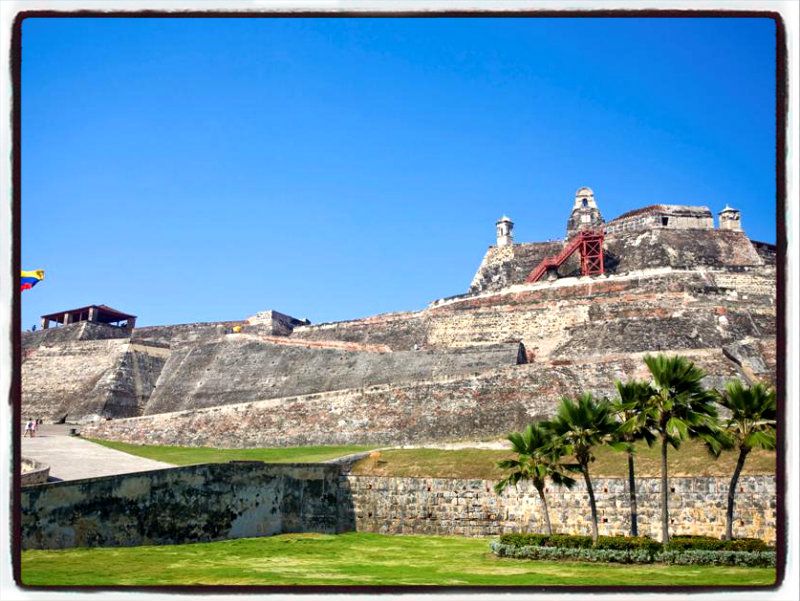
Castillo San Felipe de Barajas (San Felipe Castle)
5. Plan a day trip to Playa Blanca. Cartagena is located on the water, but if you’re looking for a beautiful beach, take a 30 minute speed boat ride over to Playa Blanca on the nearby Rosario Islands. The price of the trip starts at $40,000 COP ($20 USD). This does not include the $12,000 COP ($6 USD) park entrance fee. Prices increase from there depending on what the trip includes (i.e. lunch, snorkeling, etc.). You’ll be able to find many options at the marina. Save yourself money and a headache by purchasing tickets directly from the captain and avoiding middlemen with empty promises. Bring only what you need to the beach. If you feel like making a night of it, hammocks and rustic cabanas are available starting at $10,000 COP ($5 USD).
Well, that depends on what kind of backpacker you are…
If you enjoy a sense of security, quiet time after hours, old city charm, and quick access to historical sites,
Stay in the Walled City. Everything you need is in walking distance and its safe to walk at night! Great food, beautiful architecture, grocery shopping, souvenir shopping — its all here. The price of hostels start at $25,000 COP ($12.50 USD).
If you are traveling to meet other young people and are looking for the hot spot among backpackers…
Choose a hostel on Media Luna. Media Luna is a street 10-15 minutes (by foot) outside of the Walled City in an area called Getsemani. Hostels here are notorious for being the site of parties in the street until the wee hours of morning and attract young backpackers looking to have a good time interacting with other gringos. These hostels are a bit less taken care. Be sure to lock up your belongings, as bathrooms inside shared dorms are open to party-goers off the street. Hostel Mamallena is a popular option starting at $25,000 COP ($12.50 USD) for a shared dorm.
While Colombia isn’t exactly famous for any one type of cuisine, you’ll never go hungry here. A typical Colombian dish or “menu del dia” (menu of the day) consists of a small salad, rice, beans, meat, and soup and can cost $6,000-12,000 COP ($3-6 USD). While you’re in the city be sure to try an “arepa”, which consists of a grilled or fried homemade bun and is stuffed or topped with cheese. These can be found all over from different food carts and cost no more than $2,000 COP ($1 USD). Don’t miss Colombia’s native fruits, including the delicious “lulo” that can be blended into an amazing cocktail or eaten with a spoon. “Aguardiente” is the liquor of choice in Colombia. It is made from sugar cane and its closest English translation is “fire water,” so maybe be careful with that.
By the way, the water is drinkable in Cartagena.
Hostel: $25,000 COP ($12.5 USD)
Food: $35,000 COP ($17.50 USD)
Activities: $12,000 COP ($6 USD)
Total: $72,000 COP ($36 USD)
Wingsuits are so awesome. Here is a wingsuit stunt from the Nuit de la Glisse film “Imagine, Life spent on the Edge” involving some seriously technical camera work and intense music. Enjoy!
Hakuna Matata